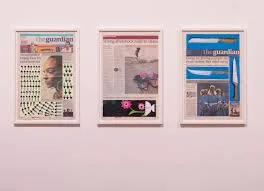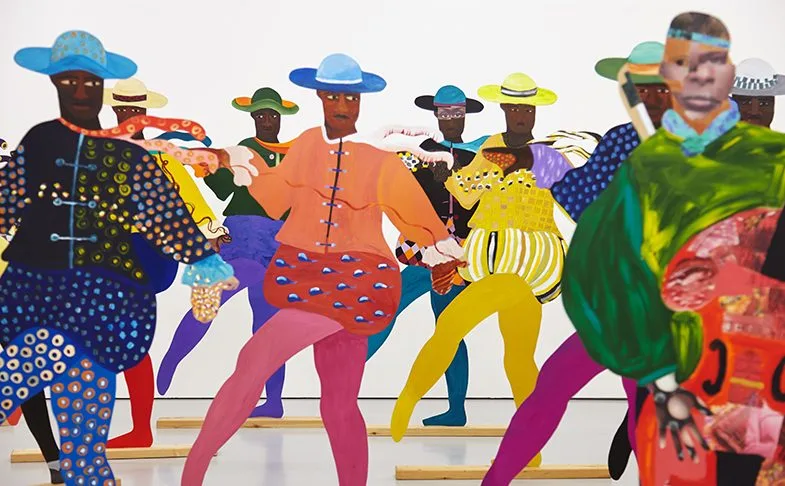Lubaina Himid, in her piece of work “Negative Positives: 2007-2015”, takes the issue with how the Guardian uses images of black people. She consequentially recrafts the pages of the Guardian using her own graphic images. Lubiana Himid acquires pages from what she terms “our liberal paper” and then paints across them. She carefully paints the paint every time with colour and a sophisticated graphic touch[1]. The result is a patchwork intervention, leaving many original elements alone, that exposes unwitting cultural habits and expectations. It creates a sort of crossword in the relationship between a headline about knife crime, for example, and a photograph of a winning sportsman or woman and leads the eye and brain across. As one reads and looks across the newspaper, she plays along with the disposability of the paper, increasing the speed between a reader glancing at the work, absorbing the content, and discarding the paper. The implication is a perfunctory comment instead of the weighty politics; value in each message, which collectively makes great sense. A combination of decorative and attractive builds understanding over time.
The works in the “Negative Positives” series add up to an instruction on the way the image of a black person is used in a witting and unwitting level of caricature. The patterns she paints across the surface of the newspaper are invented and borrowed to point out the strange and inappropriate use of people as signifiers. For example, the association of Didier Drogba, while putting his fingers around his eyes (“Did you see me”), signifies the unconscious associations around the representation of a black man or woman. She uses different strands of association, such as painting Ashanti fabric patterns, a bright snake that crosses the page, and flowers that echo the flowers in a painting in a photograph of a dead child in Haiti.
There is usually an unseen heaviness, lightness, horror, and humour that exists side by side on a newspaper page. Himid, wit fully and closely, takes the eye of the reader from the image past the headline to the edge and then back again. He uses these techniques to show that the “liberal” press simultaneously visualizes and dismisses the lives of black people. Her graphics interventions achieve a counter pattern and beat by blanking out whole sections with colour. She leaves dark pools of reference beneath.
Turner Prize is a yearly honour that is given to a visual craftsman in or situated in Great Britain to recognize an extraordinary display or other introduction of his or her work. The Turner Prize is viewed as the highest respect in the British craftsmanship world. The honour was set up in 1984 by the Patrons of New Art and named after an English Romantic painter called J.M.W. Turner. In the early years, the award had a very competitive selection process that allowed up to six nominees for shortlisting, from which a winner was chosen.
The selection was originally unfocused, where the eligibility for the award was unrestricted. Up-and-coming artists, established artists, art administrators and critics were all eligible for Turner Prize. However, in 1991, these criteria were revised, and the annual shortlist included only artists, and the number of nominees was reduced to only four[2]. Also, the nominees’ ages were limited to below fifty years. The nominees are shortlisted based on the strength of the exhibitions they presented within the previous twelve months. In 2017, the age limitation was, however, retracted because the up-and-coming artists did not necessarily equate to youth. Both the shortlist and establishing the winner are carried out by a five-person jury that is chaired by the director of Tate Britain.
Both the British media and the public have developed a keen interest since the inception of the Turner Prize. Therefore, once shortlisting has been done, there has always been fierce debate regarding the merits of the nominated artists and occasional debates on the very definition of art. The jury usually discussed a special exhibition of the nominees that was originally being held at Tate Britain. However, since 2011, the exhibitions have been alternating yearly between the Tate Britain and a gallery outside London. The decision on selecting the winner, does not only rest on these exhibitions but also on the work for which the artist was originally nominated. The awarding ceremony is usually televised at the end of the year, and the winner receives £25,000, and the three runners-up receive £5,000 each[3].
These historical statistics played a major role in the nomination and the eventual win of Lubaina Himid for the Turner Prize. Lubaini Himid won the award at the age of 63 and is considered the specious triumph of age. Similarly, she is the first black person to win the honourable award since its inception. The original criteria used to nominate the place was an upper limit of 50 years, which limited the eligibility of various artists. However, with the retraction of this upper age limit, Himid got a chance to showcase her exhibitions and finally emerged victorious over the four nominees. It also provided a chance to show fairly good work that lacks much risk and provokes the crazy, mad-cap antics of youth. Therefore, the significance of retraction of this age limit proved Himid to showcase her works from the 1980s. Her work “Negative Positives” remarkably depicts racial misinterpretation and plays a major role in her win.
The criteria initially used to select the nominees and the winner of the Turner Prize played a major role in delaying Himid’s win. With her work from the 1980s, she could have won the prize earlier in her life. However, her piece of work, “Negative Positives”, which earned her the nominations, was developed between the years 2007 and 2015[4]. Therefore, despite being within the age bracket during her early work, she could not win the prize because she had not developed the piece of work that would her nomination. Unfortunately, once “Negative Positives” was developed, she was passed over the upper age limit and could not be nominated. The retraction of the age limit in 2017 provided her with the opportunity to exhibit her works, eventually earning her nomination. Therefore, the upper age limit initially hindered Himid from winning the award. However, its retraction was fundamental to Himid’s win of the Turner Prize award.
Colonization is the process of acquiring colonies. European powers took over the African lands by force and then steeled the Europeans on these lands[5]. The conquered land was referred to as a colony. Over the course of history, most African countries were colonized by European powers such as Britain, France, Italy, Belgium and Germany. Each of these powers acquired a colony in Africa and exercised their full power in controlling the economic, political and social structures of the African society.
These powers had come as missionaries and explorers initially, bringing Christianity and Western civilizations to the local people without considering the appropriateness of their actions. However, the main idea for colonization was to exploit the resources of the colony to benefit the colonizing country. The black, Indigenous people that were colonized felt the negative effects of the colonization by foreign countries. These effects were felt negative impacts on the social, economic, and political, structures of indigenous, non-industrialized people. These effects extended to the post-colonial black people, whose achievements in the world were,e in most cases, overlooked.
The significant impact of colonization on black people during and after the colonization process is racial discrimination. In the colonies, the colonizers created social classes that deemed the Africans as the lowest class of humans. For example, in South Africa, there was the apartheid rule that segregated the citizens of the country based on the colour of their skin. There were different roads, healthcare facilities, and schools for the white people and the black people, whose qualities were vastly different. The whites received the best facilities and infrastructure, while the blacks were accorded the poorest qualities of facilities and infrastructure.
Such racial discrimination continued even after colonization was abolished and the African countries accorded their freedom[6]. The idea that blacks are the lowest creation had already been planted in people’s minds by the time the countries had acquired their freedom. However, it is worth noting that this idea existed before colonization, and colonization only heightened it. The slaves mostly used in the American cotton farms were of African heritage. The idea that Africans are inferior has affected the achievements of black people because it is believed that blacks are inferior and should not compete with whites for positions. Therefore, colonization indirectly created an inferiority complex for the coloured people that hindered their ability to compete with the whites equally.
Art has always been employed as a creative way by artists to fight for social justice since art shows the freedom of one to express one’s emotions without necessarily speaking any words. Such art can be paintings, music, shows, poems, and movies that are presented to the audience. These arts are usually articulated in witty and creative ways that provoke the thinking of the audience. For example, “Negative Positives” by Lubiaina Himid wit fully and creatively shows the misrepresentation of blacks in society while showing the effects of this misinterpretation on blacks. These arts centre around the problems faced specifically by the blacks because of their colour in the society they live in. They then try to offer alternative solutions as well as airing these plights to the whole population.
Because these arts usually focus on the problems faced by the blacks, and they relate these problems to the colour of their skin. Racism is a wide word that is not restricted to an individual or group. In a narrow sense, racism refers to the oppression of a specific individual or group of individuals in a society by another group of society[7]. For example, the oppression of people with coloured skin by non-coloured groups or individuals in society. In a broader definition, it is used to describe the fight over social rights by two distinct groups of society. Since the arts by Blacks are aimed to highlight the social injustice faced by blacks, depicting a clear diversity between the coloured and non-coloured individuals, it can be viewed that the artists are trying to create certain differences between the two groups of society. Such emphasis on the differences creates a widened gap between the groups, causing tension among the members[8]. Therefore, they are amplifying the already racial discrimination, hence promoting racism.
Guilt is defined as the unhappy feeling that arises when a person either does or thinks he or she has done something wrong. It is the remorse that results from a person’s responsibility for some offence. White guilt, along these lines, is the aggregate blame felt by the racial treatment of minorities by the whites both verifiably and presently. It is frequently expressed as the psychosocial cost of prejudice for the white individual alongside the capacity to have sympathetic reasons towards bigotry and dread of non-whites. The civil rights movement and Black Power movement confronted the whites, who later acknowledged the blacks’ growing existence and importance. The whites there had to deal with the previous attitudes towards the blacks and the suffering of the blacks because of these attitudes.
In art, white guilt is evident, with the whites presently starting to appreciate arts by the blacks. For example, Hidim previously could not make it to the nominations for the Turner Prize despite her astonishing works. However, white guilt helped the non-coloured individuals to realize that arts is a universal language that can be used to communicate with anyone[9]. They later appreciated her work in representing blacks by recognizing her efforts and awarding her the Turner Prize winner award in 2017. Similarly, there has been a growing appreciation of the Hip-Hop culture that was once considered black music in the United States. Several white rappers currently identify with the genre as a way of social change rather than the previous view of the music used to promote the black culture and create a divide.
The white guilt has put the whites in a catch twenty-two position. On one hand, when the shows they create do not constitute the blacks, they are deemed to be racist. However, on the other hand, when they constitute the blacks in their shows, they are blamed for not portraying blacks in the right manner. Therefore, there is a dilemma faced by the whites on the way to represent the blacks in the shows or any art. One art by Himid that can be used to describe the above situation is ‘Now Come On’, where she created paintings from the pages of the Guardian on the front page by an Irish novelist, Anne Enright o. Ugandan midwives how were photographed in impressive phalanx; arms clasped in front of them, ready to serve.
On the front page, the headline on the top of the page is, however, about violent crime: “Gangs are getting and more violent, Met chief warns.” Himid believed that this was a misrepresentation of the blacks by associating blacks with a headline that was not befitting. She ends up putting paintings of three long, brutal knives on the story covered by the headline, leaving an advert at the bottom intact. There is also the example of the weekend magazine that covered the story of poet and activist Maya Angelou on the front cover. On the back cover, there is an advertisement for an insurance company featuring an image of a spade. Spade has been used as a synonym for the word “nigger.”[10]
Despite the importance of the advert, it is unnecessary to put a picture of a spade or the word spade next to an image of a black person. Therefore, as much the whites try to depict the case of involving blacks in the arts and media. However, it is a failure because, in the end, they end up showing the wrong or unwanted image of the blacks. Ultimately, the whites, while acting due to white guilt, end up undermining the blacks without even realizing they are doing it[11]. Himid looks for such photos in the newspapers and edits them to make the black lives visible. However, in doing so, she seems to be a racist, which cost her nomination for the Turner Prize sooner.
Art is usually a form of communication that is creatively designed so that every individual can interpret his or her meaning from his or her own understanding of the artwork. Since human is designed to accept and make conclusions based on findings that help them promote their good, it is hard to view a common view regarding a single art. Arts speak to the inner soul of a person, and each individual takes the perspective that represents him or her the most. Therefore, institutions such as Tate it is expected to have their own perspective and understanding of art. Because of the power they possess, such institutions use it to their advantage to decide the meaning of art and only accept it when they relate to it well enough. Therefore, these institutions, such as Tate, will only want the art that they feel represents their view on how blacks are portrayed.
In “Naming the Money”, Himid uses art to show how the un-named captured in slavery were used by their wealthy owner used them as servile adornment. Himid believes that everything about slavery during the slave trade was about money. The painting indicates how the rich classes all over Europe have spent their plunder, paraded their influence and riches utilizing Africans as slaves. It demonstrates how camouflaged and glamourized; they looked like workers or were wearing the garments of squires, they regularly gave excitement just by appearing to be unique and were at their most valuable as the best prominent show of riches possible[12]. It shows how much contributions that Africans have made to the economic foundation of Europe.
Canon is described as the body of work which has been built up as illustrative of the best cases of a specific genre. The works of art that are incorporated into the cannon are thought to be perfect works of art[13]. The works incorporated into the ordinance set a standard from which different gems, regardless of whether new or old, which are excluded from the group, can be judged. Thus, canonization is the way to put workmanship as the agent of a specific sort to set principles for which different expressions not in the gun can be judged. Lubiana’s works are used as a canon, hence creating a masterpiece because of their uniqueness and their purpose in fighting social injustice[14]. Therefore, Himid’s work showed originality in depicting the representation of the black, which was viewed to be promoting racism. Hence, recognition of the significance of her works by the institutions took a while and combined with factors such as the upper age limit, denied her the opportunity to win the Turner Prize sooner.
Ironically, the institutions that are supposed to promote art deny chance to the artists who wish their work to be known and recognized. Artists always want to expand their definition of art because, in a way, art is a philosophical quest[15]. Institutions such as Tate create barriers such as creating criteria that make it difficult for the artists to display their art and pass their ideas to the audience w, who will eventually decipher its meaning. Artists comprehend that art does not mean the items to which the viewer pays serious tribute or hanged in the exhibition. The thoughts can be communicated by the method for acts that occurred without living insignificant followers on the planet. Once an artist understands this, he or she can move on to different ways to expose his or her art without necessarily going to institutions such as Tate for recognition of their art.
The expression “Black Arts Movement” depicts a course of action of perspectives, convincing from 1965 to 1976 about African-American social development that acknowledged that radical engagement was a basic commitment of black authorities[16]. It also broadcasted that the primary authentic governmental end of black craftsmen was an opportunity from white administrative and stylish authority structures. The Black Arts Movement additionally arranged the route for consequent coloured artists, who have moved far from essentialist racial portrayals to explain an all the more sweeping, multifaceted comprehension of racial personality. However, the black arts movement collapsed because it had failed to organize itself to fight for black arts. The black arts movement, at one point, became a resistance that caused the development of a negative attitude towards black artists. This attitude majorly contributed to the overlooking of the work by Hidim, creating a situation where her work to a while to be perceived.
Black Lives Matter is a conceptual and political intervention in our present realism where Black lives are methodically and deliberately highlighted for the end[17]. It is an authentication of Black individuals’ duties concerning this whole population, our civilization, and our flexibility despite lethal abuse. The Black Lives Matter improvement is a proposal to make a move to encourage people to stand together against racial irregular characteristics against black people and to fight against the wants of averageness described by racial mastery[18]. This call for equality helped raise the significance of Hamid’s on the inequality faced by the blacks. It opened an avenue for the nomination and eventual win of the Turner Prize by Lebuiana Himid.
Bibliography
Afro-Blanket, Sonia Boyceis. “Multicultural discourses.” Feminist Visual Culture (2016).
Ambroise, J.R. and Broeck, S. eds., 2015. Black Knowledges/Black Struggles: Essays in Critical Epistemology. Oxford University Press.
Arya, Rina. “Rethinking Black Art as a Category of Experience.” Visual Culture in Britain 18, no. 2 (2017): 163-175.
Black, Hannah. “Lubaina Himid: Revision.” Afterall: A Journal of Art, Context and Enquiry 43, no. 1 (2017): 6-17.
Button, Virginia. The Turner Prize: 2005. Tate, 2005.
Dixon, Carol Ann. “The’othering’of Africa and its diasporas in Western museum practices.” PhD diss., University of Sheffield, 2016.
Fredrickson, George M. Racism: A short history. Princeton University Press, 2015.
Iyer, Aarti, Colin Wayne Leach, and Faye J. Crosby. “White guilt and racial compensation: The benefits and limits of self-focus.” Personality and Social Psychology Bulletin 29, no. 1 (2003): 117-129.
Iskin, R. E. (Ed.). (2016). Re-envisioning the Contemporary Art Canon: Perspectives in a Global World. Taylor & Francis.
Matter, Black Lives. “All# BlackLivesMatter. This is Not a Moment, but a Movement.” Retrieved on August 14 (2015): 2015.
Garza, Alicia. “A herstory of the# BlackLivesMatter movement.” Are all the women still white (2014): 23-28.
McCabe, Susan. “BLACK ARTS MOVEMENT.” American Poets and Poetry: From the Colonial Era to the Present [2 volumes]: From the Colonial Era to the Present (2015): 76.
Pallua, Ulrich, Adrian Knapp, and Andreas Exenberger. “(Re) Figuring Human Enslavement: Images of Power, Violence and Resistance.” (2014): 256.
Pollock, Griselda. “‘How the political world crashes in on my personal everyday’: Lubaina Himid’s Conversations and Voices: Towards an Essay About Cotton. com.” Afterall: A Journal of Art, Context and Enquiry 43, no. 1 (2017): 18-29.
Pollock, Griselda. “56th Venice Biennale.” Art Monthly 387 (2015): 20.
Thatcher, Jennifer. “Lubaina Himid: Invisible Strategies Navigation Charts.” Art Monthly 404 (2017): 20.
Appendix I: Negative Positives
Lubaina Himid, Negative Positives: The Guardian Archive, 2007-2015. The Turner Prize Exhibition. Ferens Art Gallery, Hull. Photo: David Levene
Appendix II
Lubaina Himid Naming the Money (2004) Installation view, Navigation Charts Spike Island (2017) Courtesy the artist, Hollybush Gardens and National Museums Liverpool: International Slavery Museum. Photograph by Stuart Whipps
- Ibid ↑
- Button, Virginia. The Turner Prize: 2005. Tate, 2005. ↑
- Ibid ↑
- Thatcher, Jennifer. “Lubaina Himid: Invisible Strategies Navigation Charts.” Art Monthly 404 (2017): 20. ↑
- Pallua, Ulrich, Adrian Knapp, and Andreas Exenberger. “(Re) Figuring Human Enslavement: Images of Power, Violence and Resistance.” (2014): 256 ↑
- Fredrickson, George M. Racism: A short history. Princeton University Press, 2015. ↑
- Ibid ↑
- Fredrickson, George M. Racism: A short history. Princeton University Press, 2015. ↑
- Iyer, Aarti, Colin Wayne Leach, and Faye J. Crosby. “White guilt and racial compensation: The benefits and limits of self-focus.” Personality and Social Psychology Bulletin 29, no. 1 (2003): 117-129. ↑
- Ambroise, J.R. and Broeck, S. eds., 2015. Black Knowledges/Black Struggles: Essays in Critical Epistemology. Oxford University Press. ↑
- Afro-Blanket, Sonia Boyceis. “Multicultural discourses.” Feminist Visual Culture (2016). ↑
- Dixon, Carol Ann. “The’othering’of Africa and its diasporas in Western museum practices.” PhD diss., University of Sheffield, 2016. ↑
- Iskin, R. E. (Ed.). (2016). Re-envisioning the Contemporary Art Canon: Perspectives in a Global World. Taylor & Francis. ↑
- Ibid ↑
- Pollock, Griselda. “56th Venice Biennale.” Art Monthly 387 (2015): 20. ↑
- McCabe, Susan. “BLACK ARTS MOVEMENT.” American Poets and Poetry: From the Colonial Era to the Present [2 volumes]: From the Colonial Era to the Present (2015): 76. ↑
- Garza, Alicia. “A herstory of the# BlackLivesMatter movement.” Are all the women still white (2014): 23-28. ↑
- Matter, Black Lives. “All# BlackLivesMatter. This is Not a Moment, but a Movement.” Retrieved on August 14 (2015): 2015. ↑
Cite This Work
To export a reference to this article please select a referencing stye below:









